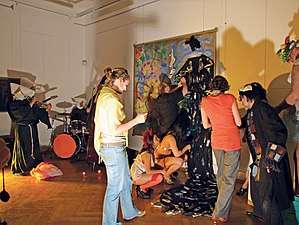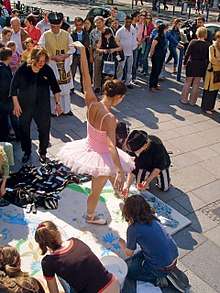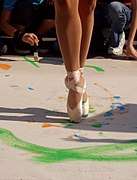Requiem for Mobile Telephones
| Requiem for Mobile Telephones | |
|---|---|
 | |
| Artist | Lubo Kristek |
| Year | 2007–2010 |
| Medium | interactive assemblage |
| Dimensions | 300 cm × 210 cm × 80 cm (120 in × 83 in × 31 in) |
Requiem for Mobile Telephones[1] is an interactive assemblage[2] of the performance artist Lubo Kristek and also a series of his happenings. The artist started his happening series in 2007 to protest against the addictions to new technologies. He asked the audience to give up their mobile phones and use them to create an assemblage.[3]
Background
The first action was held in the city of Znojmo. The spectators sewed the mobile phones directly on to the artist wearing a jacket with a train (the jacket then became the basis for new assemblage).
The second happening took place in public area – on the pavement of Mariahilfer Straße in Vienna in 2007. Kristek who likes to remove the barriers between art and reality, deliberately got with his action in the way of passers-by to pull them out of their stereotype and to force them adopt an attitude. The artist dipped the balerina’s pointe shoes into the paint and let her dance on a blank canvas.[4] The pointe shoes also became part of the assemblage afterwards. Then he invited school pupils and passers-by to help to create the new assemblage, to paint and sew more mobile phones on to it. Art and life merged in the avant-garde sense.
The assemblage travelled to an exhibition at the Barockschloß Riegersburg, today Schloss Ruegers (2007). The artist continued to travel with his mission to other states. With each happening interaction the assemblage changed its shape.
In 2008, the happening series continued in the Neues Stadtmuseum, Landsberg am Lech. It was part of the retrospective exhibition of the works by Lubo Kristek titled Third Eye of Distant Communication.[5]
In the happening a new character appeared, Temptation (played by the prima ballerina of the Brno National Theatre Jana Přibylová), who gives the spectators electronic devices from a pink sack and who suddenly turnes into the devil). In one of the last scenes, this character toys with a representation of human fate – a black figurine – which she throws to the ground as soon as she tires of her plaything. At the end of the happening, Kristek carried the pink sack full of electronic refuse to the altar of the Landsberg Church of the Holy Cross. In this way, he emphasised the sharp contrast between our ancestors´ legacy and what will remain after the current epoch.[6]
The following happening took place in a Polish city of Sucha Beskidzka in 2010. According to Kristek, the relationship of contemporary society to the mobile telephone bears the traits of a cult or even a pathological dependency. Therefore he places this “modern god” on the altar (with the inscription Rest in Peace) and lets a giant triple-breasted angel to drill it through. The participants of the happening actively contribute to the act of sacrificing the mobile phones.
The artist destroys the mobiles in the happenings. He disposes of them like refuse, but at the same time, he applies the ritual principle of sacrifice. The participants of the happening then “receive” the destroyed telephone (analogous with the torn up god) or even “consume” it via their reconnection in the creative process (analogous with the resurrection). The characters and spectators sew the mobiles on to the travelling assemblage, and they become co-creators of a work of art with a shape that changes from event to event. So through his message Requiem for Mobile Telephones, Kristek achieves what he foretold in his picture The Moss Covered Telephone Call. He experiments with the involvement of the public in events at he{Clarification
interface between ritual and theatrical and creative art, with the use of random impulses during a collective creative process and with emphasis on the experiencing of the current moment. He attempts to restore lost communication and transform relations in an alienated “digital society”.[6]}}
Requiem for Mobile Telephones belongs to Kristek’s critical assemblages as well as Soundproof Aesthetic of Luxuriety (1976) that reveals the traps of consume approach and In the Prematurely Cloned Age of One Planet (2003) that questiones the ethics of current medical science.
 26. April 2007,
26. April 2007,
Mariahilfer Straße, Vienna 26. April 2007,
26. April 2007,
Mariahilfer Straße, Vienna 10. May 2008,
10. May 2008,
Neues Stadtmuseum,
Landsberg am Lech 5. June 2010, City Museum, Sucha Beskidzka
5. June 2010, City Museum, Sucha Beskidzka.jpg) 5. June 2010, City Museum, Sucha Beskidzka
5. June 2010, City Museum, Sucha Beskidzka
Literature
- Neunzert, Hartfrid (2008). Lubo Kristek: Third Eye of Distance Communication. Landsberg am Lech: Neues Stadtmuseum.
- Barbora Putová (2013). Kristek’s Glyptothek im Thayatal (in German). Brno: VÚKU. ISBN 9788090554825 (Digital ed.), ISBN 9788090554818 (Print ed.).
- Putová, Barbora (2018). Kristek Thaya Glyptotheque (1st Digital ed.). Research Institute of Communication in Art. ISBN 9788090554832. Retrieved 16 August 2018.
External Links
References
- ↑ Published in Neunzert 2008, p. 39.
- ↑ Putová 2013, p. 21.
- ↑ Putová 2013, p. 121.
- ↑ Putová 2013, p. 77.
- ↑ Rieger, Manuela (12 May 2008). "Kunst zum Nachdenken". Augsburger Algemeine (in German). Retrieved 16 August 2018.
- 1 2 Putová 2018, Chapter: Meeting place – Requiem for Mobile Telephones